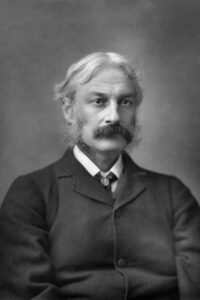
The Blue Fairy Book
Once upon a time in a certain country there lived a king whose palace was surrounded by a spacious garden. But, though the gardeners were many and the soil was good, this garden yielded neither flowers nor fruits, not even grass or shady trees.
The King was in despair about it, when a wise old man said to him:
“Your gardeners do not understand their business: but what can you expect of men whose fathers were cobblers and carpenters? How should they have learned to cultivate your garden?”
“You are quite right,” cried the King.
“Therefore,” continued the old man, “you should send for a gardener whose father and grandfather have been gardeners before him, and very soon your garden will be full of green grass and gay flowers, and you will enjoy its delicious fruit.”
So the King sent messengers to every town, village, and hamlet in his dominions, to look for a gardener whose forefathers had been gardeners also, and after forty days one was found.
“Come with us and be a gardener to the King,” they said to him.
“How can I go to the King,” said the gardener, “a poor wretch like me?”
“That is of no consequence,” they answered. “Here are new clothes for you and your family.”
“But I owe money to several people.”
“We will pay your debts,” they said.
So the gardener allowed himself to be persuaded, and went away with the messengers, taking his wife and his son with him; and the King delighted to have found a real gardener, entrusted him with the care of his garden. The man found no difficulty in making the royal garden produce flowers and fruit, and at the end of a year the park was not like the same place, and the King showered gifts upon his new servant.
The gardener, as you have heard already, had a son, who was a very handsome young man, with most agreeable manners, and every day he carried the best fruit of the garden to the King and all the prettiest flowers to his daughter. Now this princess was wonderfully pretty and was just sixteen years old, and the King was beginning to think it was time that she should be married.
Read or download Book
Andrew Lang
Andrew Lang FBA (31 March 1844 – 20 July 1912) was a Scottish poet, novelist, literary critic, and contributor to the field of anthropology.
Biography.
He is best known as a collector of folk and fairy tales. The Andrew Lang lectures at the University of St Andrews are named after him Lang was born in 1844 in Selkirk, Scottish Borders. He was the eldest of the eight children born to John Lang, the town clerk of Selkirk, and his wife Jane Plenderleath Sellar, who was the daughter of Patrick Sellar, factor to the first Duke of Sutherland. On 17 April 1875, he married Leonora Blanche Alleyne, the youngest daughter of C. T. Alleyne of Clifton and Barbados. She was (or should have been) variously credited as the author, collaborator, or translator of Lang’s Color/Rainbow Fairy Books which he edited. He was educated at Selkirk Grammar School, Loretto School, and the Edinburgh Academy, as well as the University of St Andrews and Balliol College, Oxford, where he took a first class in the final classical schools in 1868, becoming a fellow and subsequently honorary fellow of Merton College. He soon made a reputation as one of the most able and versatile writers of the day as a journalist, poet, critic, and historian. He was a member of the Order of the White Rose, a Neo-Jacobite society that attracted many writers and artists in the 1890s and 1900s. In 1906, he was elected FBA.
He died of angina pectoris on 20 July 1912 at the Tor-na-Coille Hotel in Banchory, Banchory, survived by his wife. He was buried in the cathedral precincts at St Andrews, where a monument can be visited in the southeast corner of the 19th-century section. Lang’s writings on Scottish history are characterized by a scholarly care for detail, a piquant literary style, and a gift for disentangling complicated questions. The Mystery of Mary Stuart (1901) was a consideration of the fresh light thrown on Mary, Queen of Scots, by the Lennox manuscripts in the University Library, Cambridge, approving of her and criticizing her accusers. He also wrote monographs on The Portraits and Jewels of Mary Stuart (1906) and James VI and the Gowrie Mystery (1902). The somewhat unfavorable view of John Knox presented in his book John Knox and the Reformation (1905) aroused considerable controversy. He gave new information about the continental career of the Young Pretender in Pickle the Spy (1897), an account of Alastair Ruadh MacDonnell, whom he identified with Pickle, a notorious Hanoverian spy. This was followed by The Companions of Pickle (1898) and a monograph on Prince Charles Edward (1900). In 1900 he began a History of Scotland from the Roman Occupation (1900). The Valet’s Tragedy (1903), which takes its title from an essay on Dumas’s Man in the Iron Mask, collects twelve papers on historical mysteries, and A Monk of Fife (1896) is a fictitious narrative purporting to be written by a young Scot in France in 1429–1431.






